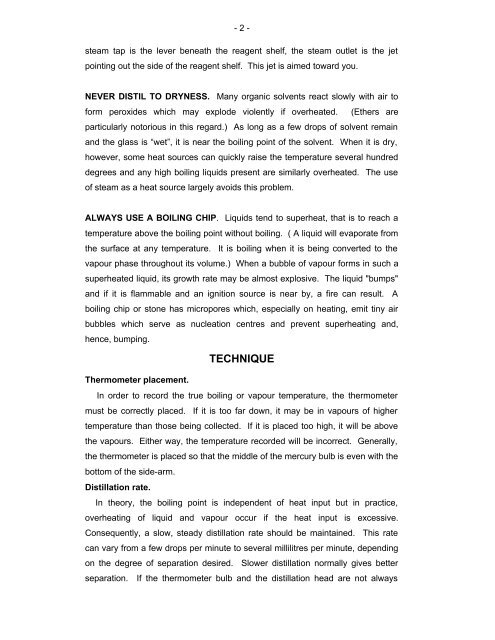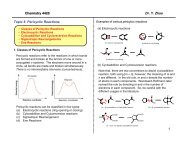crude trimyristin - Chemistry
crude trimyristin - Chemistry
crude trimyristin - Chemistry
Create successful ePaper yourself
Turn your PDF publications into a flip-book with our unique Google optimized e-Paper software.
steam tap is the lever beneath the reagent shelf, the steam outlet is the jet<br />
pointing out the side of the reagent shelf. This jet is aimed toward you.<br />
NEVER DISTIL TO DRYNESS. Many organic solvents react slowly with air to<br />
form peroxides which may explode violently if overheated. (Ethers are<br />
particularly notorious in this regard.) As long as a few drops of solvent remain<br />
and the glass is “wet”, it is near the boiling point of the solvent. When it is dry,<br />
however, some heat sources can quickly raise the temperature several hundred<br />
degrees and any high boiling liquids present are similarly overheated. The use<br />
of steam as a heat source largely avoids this problem.<br />
ALWAYS USE A BOILING CHIP. Liquids tend to superheat, that is to reach a<br />
temperature above the boiling point without boiling. ( A liquid will evaporate from<br />
the surface at any temperature. It is boiling when it is being converted to the<br />
vapour phase throughout its volume.) When a bubble of vapour forms in such a<br />
superheated liquid, its growth rate may be almost explosive. The liquid "bumps"<br />
and if it is flammable and an ignition source is near by, a fire can result. A<br />
boiling chip or stone has micropores which, especially on heating, emit tiny air<br />
bubbles which serve as nucleation centres and prevent superheating and,<br />
hence, bumping.<br />
Thermometer placement.<br />
TECHNIQUE<br />
In order to record the true boiling or vapour temperature, the thermometer<br />
must be correctly placed. If it is too far down, it may be in vapours of higher<br />
temperature than those being collected. If it is placed too high, it will be above<br />
the vapours. Either way, the temperature recorded will be incorrect. Generally,<br />
the thermometer is placed so that the middle of the mercury bulb is even with the<br />
bottom of the side-arm.<br />
Distillation rate.<br />
- 2 -<br />
In theory, the boiling point is independent of heat input but in practice,<br />
overheating of liquid and vapour occur if the heat input is excessive.<br />
Consequently, a slow, steady distillation rate should be maintained. This rate<br />
can vary from a few drops per minute to several millilitres per minute, depending<br />
on the degree of separation desired. Slower distillation normally gives better<br />
separation. If the thermometer bulb and the distillation head are not always









